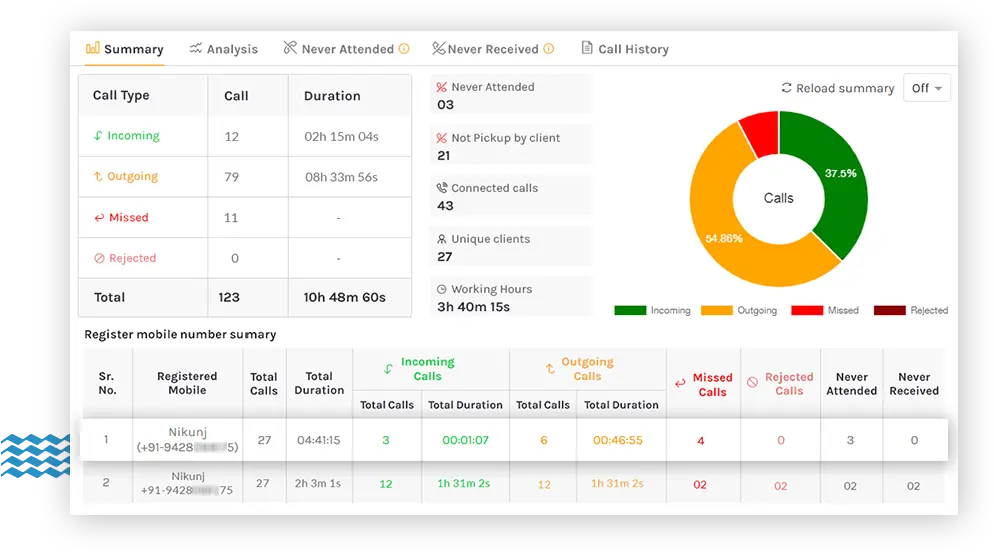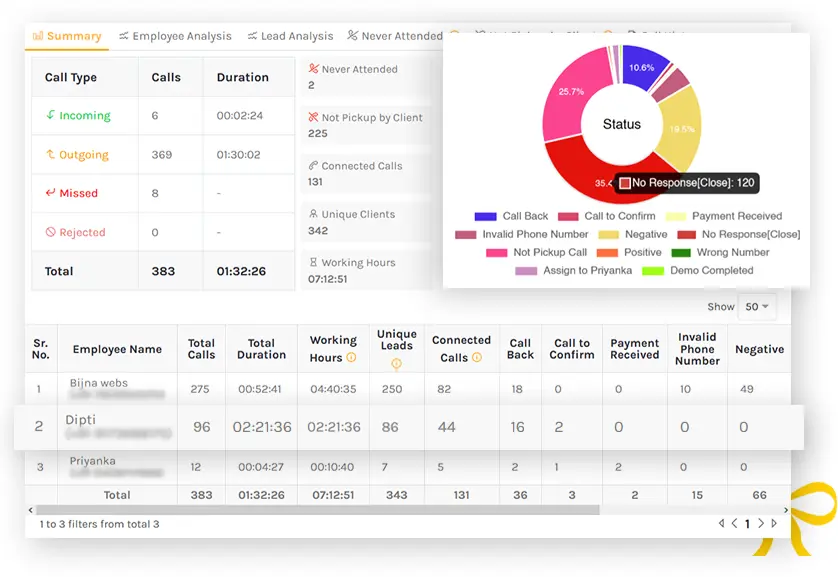In today's fast-paced business landscape, effective communication is key to success. Whether you're a sales professional, a customer service representative, or a call center manager, outbound calling plays a crucial role in reaching out to prospects, nurturing customer relationships, and driving business growth. However, the traditional methods of telecalling often come with limitations that hinder productivity and hinder seamless customer interactions.
Fortunately, with advancements in technology, a new solution has emerged: SIM-based telecalling software. This innovative software leverages the power of mobile networks and smartphones to revolutionize outbound calling operations, benefiting businesses of all sizes.
In this blog, we will explore the reasons why you should consider integrating SIM-based telecalling software into your outbound calling strategy. By understanding the advantages it offers, you can enhance your team's productivity, improve call quality, and achieve better results in your customer engagement efforts.
Integrating SIM-based telecalling software into your outbound calling workflow offers numerous advantages that can transform your business's communication capabilities. From improved connectivity and cost-effectiveness to enhanced flexibility and monitoring, this technology empowers your team to deliver exceptional customer experiences and drive tangible results.
In our upcoming articles, we will delve deeper into each of these benefits, providing actionable insights and best practices for implementing SIM-based telecalling software effectively. Stay tuned to unlock the full potential of this game-changing technology and take your outbound calling operations to new heights.
What is Outbound Calling?
Outbound calling is a proactive communication strategy used by businesses to reach out to customers and prospects. It involves making outbound phone calls with the intention of initiating conversations, providing information, promoting products or services, conducting surveys, or generating leads.
Unlike inbound calling, where customers initiate the contact, outbound calling puts the business in control of the conversation. It allows companies to actively engage with their target audience, establish connections, and drive desired outcomes.
Outbound calling is an essential component of various business functions, including sales, marketing, customer support, and market research. It serves as a powerful tool for businesses to expand their reach, nurture relationships, and achieve specific objectives.
To ensure success in outbound calling, businesses employ various strategies, including well-crafted scripts, call center technology, and skilled agents who are trained in effective communication techniques. Additionally, leveraging advanced telecalling software, such as SIM-based systems, can streamline operations and optimize productivity.
In conclusion, outbound calling is a proactive communication approach that empowers businesses to connect with their audience, drive engagement, and achieve specific goals. Whether its generating leads, closing sales, gathering feedback, or scheduling appointments, outbound calling remains a powerful tool for businesses across industries. By leveraging this strategy effectively, organizations can enhance customer relationships, expand their market reach, and ultimately boost their bottom line.
Disadvantages of Other Methods (VoIP, Virtual Dialer, etc) for Outbound Calling
While outbound calling is a crucial aspect of business communication, it's essential to understand the potential disadvantages associated with alternative methods such as VoIP (Voice over Internet Protocol) and virtual dialers. Let's explore some of the drawbacks of these methods for outbound calling:
Dependence on Internet Connectivity:
VoIP and virtual dialers rely heavily on stable and robust internet connections. Any disruption or instability in the network can lead to dropped calls, delays, and poor call quality. This can adversely affect customer interactions and create a negative impression of your business.
Complex Setup and Maintenance:
Implementing VoIP systems or virtual dialers often requires significant technical expertise and infrastructure. The initial setup can be complex and time-consuming, involving the installation and configuration of hardware, software, and network components.
Security Risks:
As VoIP and virtual dialer systems rely on internet-based transmission, they are vulnerable to security threats. Hackers can potentially intercept calls, eavesdrop on conversations, or gain unauthorized access to sensitive customer data. Implementing robust security measures is essential, adding complexity and potential additional costs.
Integration Challenges:
Integrating VoIP or virtual dialer systems with existing infrastructure, such as CRM software or other communication tools, can be challenging. Compatibility issues may arise, requiring custom development or additional investments in third-party solutions. This can result in delays and disruptions during the implementation process.
Considering these disadvantages, it's crucial to evaluate the specific requirements and limitations of your business when choosing an outbound calling method. Exploring alternative solutions like SIM-based telecalling app, which offers improved connectivity, cost-effectiveness, scalability, and enhanced analytics, can provide a more efficient and seamless outbound calling experience.
Instant Data for Success in Outbound Telecalling
Real-time data plays a pivotal role in driving success and maximizing opportunities. Having access to up-to-date information during active calling campaigns empowers agents, managers, and businesses as a whole.
Immediate Response and Adaptability:
Real-time data allows agents to respond promptly to customer inquiries or objections during a call. Whether it's having the latest product information, pricing details, or addressing specific customer concerns, real-time data enables agents to provide accurate and timely responses. This enhances customer satisfaction, builds trust, and increases the chances of successful conversions.
Lead Prioritization:
Real-time data empowers agents to prioritize and segment leads effectively. With access to current customer data and insights, agents can make informed decisions about which leads to focus on, ensuring that they are targeting the most qualified prospects. This strategic approach optimizes time and resources, leading to higher conversion rates.
Personalized Customer Interactions:
Real-time data enables agents to personalize their interactions with customers. By understanding customers' previous interactions, purchase history, preferences, or specific needs, agents can tailor their approach and provide a more personalized experience. This personal touch creates stronger connections, increases engagement, and boosts the chances of closing a sale.
Dynamic Scripting and Call Optimization:
Real-time data allows for dynamic scripting and call optimization. By analyzing real-time metrics, such as call duration, call success rates, or customer feedback, managers can make immediate adjustments to scripts or strategies. This iterative approach improves the effectiveness of outbound calls and enhances overall campaign performance.
How SIM-based Telecalling Apps Gives You Real-time Data Access?
Real-time reporting dashboards are powerful tools that provide telecalling teams and managers with valuable insights and analytics in the moment. These dashboards offer a comprehensive overview of key metrics, performance indicators, and call analytics, enabling teams to make data-driven decisions and optimize their telecalling efforts. Let's explore how real-time reporting dashboards can benefit telecalling teams and managers:
Performance Monitoring:
Real-time reporting dashboards offer an instant snapshot of call activities, including the number of calls made, answered, and missed. Managers can track agent performance metrics, such as call duration, call success rates, and conversion rates, enabling them to identify top-performing agents and areas for improvement. This visibility helps managers to address performance issues promptly and motivate agents to meet their targets.
SIM-based solution – Callyzer helps you Explore the total number of incoming, outgoing, missed and rejected calls handled by the entire team on the cloud and get valuable insights. Also, helps you analyze all communication activities with summarized as well as detailed analysis and statistics

Real-time Lead and Campaign Insights:
Real-time reporting dashboards provide live updates on lead status, allowing teams to prioritize leads based on their stage in the sales cycle. Managers can monitor lead conversions, track campaign performance, and identify trends or patterns in real-time. This empowers them to make informed decisions on lead nurturing strategies, adjust campaigns on the fly, or allocate resources effectively.
Callyzer offers a strong lead management and lead reporting system. With Callyzer you can bulk import leads and assign to specific employees. Using the app, employees can easily view and communicate with their assigned leads. Employees can update the status of leads with a note against a call log. With different reports generated by Callyzer, you can easily track performance of your employees. Also, you can view the list of leads not contacted and the status history of leads.

Scripting and Coaching Opportunities:
Real-time reporting dashboards facilitate dynamic scripting and coaching opportunities for telecalling teams. Managers can monitor live calls, identify areas where agents may need support, and provide real-time guidance or training. This enables teams to improve their call handling skills, overcome objections effectively, and deliver consistent messaging to maximize conversions.
Data-driven Decision Making:
Real-time reporting dashboards empower managers to make data-driven decisions on the spot. With access to live analytics and performance metrics, they can adjust strategies, allocate resources, or reallocate leads based on real-time insights. This agility in decision-making ensures that teams can adapt to changing circumstances and optimize their telecalling efforts for better outcomes.
How does it benefit your telecalling process?
Real-time reports provide immediate insights into key metrics such as call volume, call duration, and outcomes, allowing supervisors to monitor telecaller performance as it happens. This enables timely intervention, identification of issues, and provision of immediate feedback and coaching, leading to improved performance, enhanced efficiency, and better overall results in the telecalling process.
Also, when you use applications like Callyzer your telecalling process is further accelerated. Callyzer can streamline and optimize the telecalling process by providing valuable insights, automating tasks, enhancing lead management, facilitating integration with CRM systems, enabling performance tracking, and offering call scripting features. These benefits lead to increased productivity, improved customer interactions, and better overall results in telecalling efforts.
Next Steps: Try using Callyzer & Experience the Diff Yourself
Are you looking to revolutionize your telecalling process? Look no further than Callyzer, a powerful tool designed to enhance your telecalling efforts and deliver outstanding results. With its advanced features and intuitive interface, Callyzer can transform the way you engage with potential customers. Don't just take our word for it - try using Callyzer and experience the difference yourself.
Experience the difference that Callyzer can make in your telecalling efforts. Try it out today and unlock the full potential of your telecalling process. Discover firsthand how Callyzer can empower your team, improve customer interactions, and drive better results. Don't settle for mediocrity - embrace the power of Callyzer and take your telecalling to new heights.

